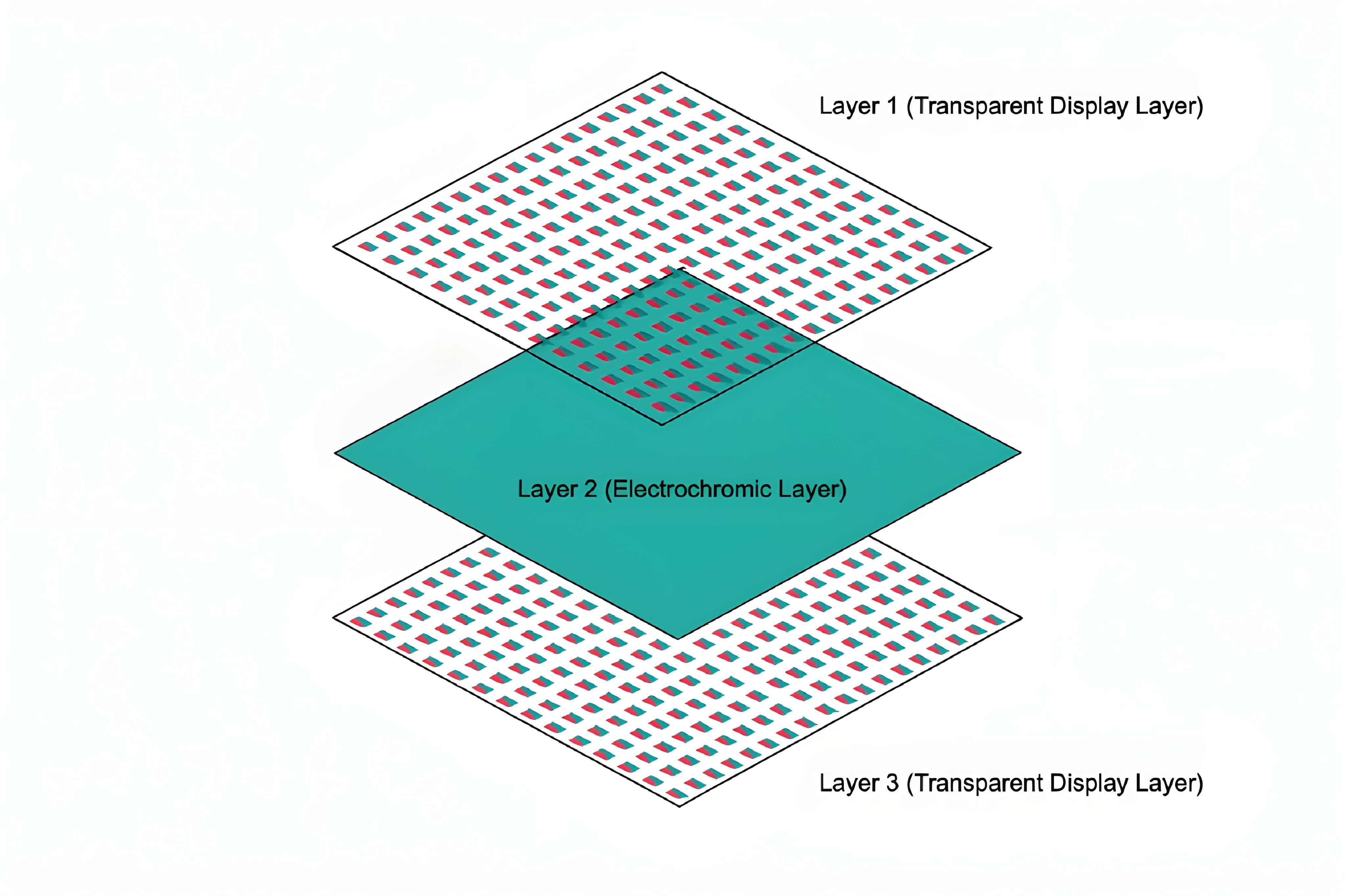
Patented. Korean Patent Publication No. KR 10-2846877
💡 What It Is
This patent describes a “Multi-Layered Display Device” (original Korean title: 다중 레이어 디스플레이 장치), a smart display system that projects images or information on both sides of a panel while allowing control over its transparency.
Think of it as a “glass sandwich” that can function as:
- A regular transparent window.
- A dual-sided screen.
- An opaque barrier for privacy and sunlight blocking.
It is designed for vehicles, buildings, and smart architecture, overcoming the visibility and functionality limits of traditional single-sided displays.
⚠️ The Problem
Conventional displays suffer from significant limitations in the era of autonomous vehicles and interactive architecture:
- Single-Sided: They typically only show content on one side.
- Lack of Versatility: Traditional setups cannot handle dual-sided viewing, adjustable opacity, or integration with real-time data without using multiple separate devices.
- Conflict of Needs: There is a growing need to display varied information (e.g., entertainment for passengers vs. ads for passersby) while simultaneously maintaining transparency for visibility or blocking light when required.
🛠️ The Solution: A Layered Approach
The invention utilizes a stacked structure of transparent layers to create a versatile, dynamic panel.
The Core Layers
- First Transparent Display Layer: A see-through screen (e.g., transparent LED, OLED, Micro LED, LCoS, or OLEDoS) that displays images on one side.
- Transparency Control Layer: Located in the middle, this layer electrically adjusts light passage. It acts like smart glass (using PDLC, PNLC, SPD, or LC tech) to switch between transparent, opaque, or partially transparent states.
- Second Transparent Display Layer: A see-through screen on the opposite side for independent or synchronized content.
Construction Details
The full stack may include inner and outer glass for protection, bonded using Optically Clear Adhesive (OCA/LOCA) or air-gap bonding. Additional clear layers or inert gases (e.g., nitrogen or argon) can be added for insulation. Crucially, pixels on the two display layers can overlap perfectly to maximize transparency or brightness.
🧠 Smarter Control by Zones
For precise operation, the layers are divided into controllable sections:
- Display Zones: The display layers are split into many small zones (pixels or groups) for high-resolution imagery.
- Transparency Zones: The middle layer has fewer, larger zones that overlap with groups of display zones.
This zoning enables hybrid modes, such as displaying information in one corner while keeping the rest of the window transparent. A central unit manages these transitions, ensuring smooth changes (e.g., adjusting transparency seconds before an image appears).
⚙️ How It Works
A central controller sends signals to each layer based on user needs or sensor inputs.
| Mode | Description |
|---|---|
| Independent Dual-Screen | The middle layer becomes opaque. Different content plays on each side (e.g., a movie inside, ads outside). |
| Enhanced Brightness | The middle layer becomes transparent. Both screens show the same image with overlapping pixels, doubling brightness and saving energy. |
| Transparent Mode | Displays turn off and the middle layer goes clear for a standard window view. |
| Privacy/Sun Block | The middle layer turns opaque to block views, glare, or sunlight, protecting the interior and components. |
In vehicles, this system integrates with sensors (speed, temperature, navigation) to display real-time data. Advanced versions can even track passenger gaze to selectively show external views or information.
🚀 Extra Capabilities
- Extended Stack: Optional extra transparency layers on the inner or outer sides provide better sunlight protection and thermal efficiency.
- Optics and Protection: A lenticular lens can be added for 3D depth. Opaque modes reduce the brightness required from the screens, extending their lifespan.
- Gaze Tracking: Using interior cameras, the system can track a user’s eyes to display relevant external content (e.g., from outside cameras) specifically in the area they are looking at.
- Damage Prevention: The system can automatically block sunlight before it reaches sensitive display layers.
🏙️ Where It Fits (Applications)
- Vehicles: Replacing windows, sunroofs, or partitions in cars, buses, or autonomous vehicles for internal entertainment and external communication.
- Buildings: Smart windows in offices or retail facades that show internal schedules and external promotions while managing light and privacy.
- Other Uses: Public transport information, interactive billboards, or retail displays.
🌟 Benefits
- Versatility: True dual-sided viewing with tunable transparency.
- Energy Efficiency: Synchronized layers lower brightness requirements, prolonging component life.
- Protection: Opaque states shield the interior from sun damage.
- Customization: Fine-grained zones allow for targeted displays and context-aware operation.
- Practical Build: Designed for real-world manufacturing with established bonding and insulation techniques.
📜 What the Patent Covers
- The Stack Structure: Two transparent display layers with a transparency control layer in between.
- Pixel Alignment: Aligned pixels for higher transparency and boosted brightness effects.
- Zone Mapping: The specific method of mapping multiple display zones to single transparency zones.
- Control Logic: Algorithms for adjusting transparency relative to content display and sequencing for extended stacks.